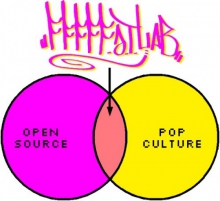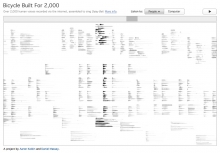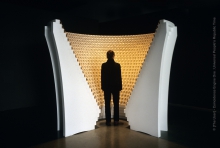Every year transmediale and CTM invite submissions to the transmediale Award. The transmediale award seeks to honor outstanding experimental artworks that embrace, question and enrich our understanding and relationship to our immersed media and technologically driven society.
Out of more than 1,500 submissions nine art projects have made their way onto the list of transmediale Award 2010 nominees. In a session of several days the members of the international jury have nominated the following artists and art collectives:
The
Free Art and Technology Lab (
FAT Lab) is an organisation dedicated to enriching the public domain through the research and development of creative technologies and media. Founded in 2007 by Evan Roth and James Powderly (also known for G.R.L.
http://graffitiresearchlab.com), over the last 2 years it has grown to 19 members, working on more than 3 continents connected through the internet. The entire
FAT network of artists, engineers, scientists, lawyers, and musicians are committed to supporting open values and the public domain through the use of emerging open licenses, support for open entrepreneurship and the admonishment of secrecy, copyright monopolies and patents.
>
www.fffff.at
The online work Bicycle Built For Two Thousand (2009) by the American artists Aaron Koblin and Daniel Massey is comprised of over 2,000 voice recordings collected via Amazon's Mechanical Turk web service. Workers were asked to listen to a short sound clip, then record themselves imitating what they heard. The result was a reconstructed version of the song 'Daisy Bell' - the first song to implement musical speech synthesis in 1962 - as rendered by a distributed system of human voices.
> www.bicyclebuiltfortwothousand.com
Felix Luque Sánchez, digital artist from Spain who works under the pseudonym Othersound, has been nominated with his audiovisual installation Chapter I - The Discovery (2009). Upon encountering a 'sci-fi geometric object' releasing a code of light and sound, the viewer's perception becomes destabilised: with a series of videos consisting of synthetically generated images one's sense of truthfulness becomes corrupted, one's faith in information undermined. Touching upon popular themes such as science fiction and AI, Luque Sánchez' work plays on relevant philosophical problems by questioning the limits of our notions of a collective image culture.
Carnivorous Domestic Entertainment Robots (2008) are a new form of domestic robots proposed by the British art collective Auger-Loizeau & Zivanovic (James Auger / Jimmy Loizeau / Alexandar Zivanovic). We leave behind the rather dull world of vacuum cleaners, lawnmowers and robotic pet dogs as we encounter a rare species of literally carnivorous furniture or household accessories. Bizzarre hybrids between machine and living organism, these entities source their energy by feeding on small flies in a similar way as predatory insects, reptiles and spiders do. Carnivorous Domestic Entertainment Robots are exotic pets that provide a dark form of entertainment competing with the spectacle of life seen in television programs such as Big Brother, Wife Swap or edited and dramatised depictions of war.
>
http://www.materialbeliefs.com/prototypes/cder.php
The Exception and the Rule (2009) is a 37' film work by British artist duo Karen Mirza & Brad Butler that emerged in relation to the artists' personal experiences in Karachi, Pakistan, during 2007 and 2008. The film is not only a response to their work with local professionals such as street vendors, Urdu translators, architects, estate agents, housing activists, lawyers, hairdressers, filmmakers, wedding photographers, newspaper printers, artists and writers, but is also an attempt to critique and understand the complex role of international and local newpapers as crucial ideological mediators on a daily basis.
The American art and design collective sosolimited (Justin Manor / Eric Gunther / John Rothenberg) has been nominated with their performance project ReConstitution, a live remix of broadcast television, and a format originally configured for the 2008 presidential elections. Technically it is a software tool for datavisualisation allowing for the extraction of video, audio, and closed captioned text from television broadcasts in real time. Using this system, sosolimited visually and sonically transform this data to a seated audience, creating an unpredictable, sometimes funny narrative by cataloguing the utterings and movements of the people onscreen.
In her works Michelle Teran (Canada) explores the interplay between social and media networks within urban environments. Her project Buscando al Sr. Goodbar (2009) is a threefold tour through the Spanish town Murcia simultaneously taking place by bus as well as on Google Earth and YouTube. Seated on a bus an audience debarks on a physical search for the locations and authors of various YouTube videos produced in the city. Whenever any such YouTube video discloses the geographical coordinates of where it was shot, the video becomes tagged onto Google Earth via a special software mapping system. The bus can be followed virtually on Google Earth while YouTube videos are screened on the bus itself. By entering the spaces where videos were produced, an intimate encounter occurrs between video makers and audience. The project can esily be repeated at other location such a Berlin as well.
The Canadian artist duo [The User] (Emmanuel Madan / Thomas McIntosh) has been selected for Coincidence Engines (2008-2009), a series of works in homage to the Poème Symphonique of 20th-century Hungarian composer György Ligeti and his sonic use of metronomes. Coincidence Engines is a proposal for a complex audio-visual re-imagination of the relationship between technological systems, culture and human experiences. In this particular series of works the mundane clicking of a clock becomes a source of rich and complex acoustic structures as [The User] employ a multitude of different time-keeping devices for an exploration into themes such as regimentation, multiplicity, (im)perfection and entropy.
>
http://www.coincidence-engines.net
With the installation Artifical Moon (2007) the Chinese artist Wang Yuyang has employed a variety of energy saving light bulbs to create a glowing four-meter sphere named after the orb of night. In a poetic way this work draws attention to the changing roles of technology and environment by highlighting the tension between the natural and the artificial. Last year Artificial Moon was suspended like a giant Chinese lantern between the trees of a public park in Xujiahui, one of the few green spots of a city in which - not unlike in many other cities of Today - the visibility of the real moon, and the stars, often retreats behind the radiance of a brightly illuminated night-time sky. Yet, also the sight of Wang Yuyang's moon is not a straight-forward material substitute: by gazing into its light we become temporarily blinded, losing sight of everything for a moment. At least in occidental terms the gaze carries with it the power of action and possession. Interestingly, the question 'who owns the moon?' used to be a favourite peg for East-West quarrels during Cold War times. Does Artificial Moon in the end perform the hint of an answer?
> http://www.bjartlab.com/read.php?73









